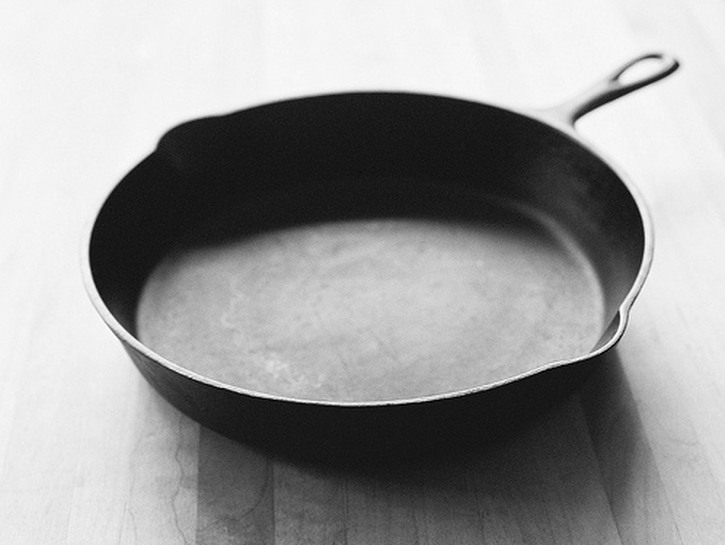Cast iron skillets are a very useful tool in many preparations in the kitchen. They are durable, long-lasting and also have the capacity to enhance each dish with flavor each time you cook. They also require very little oil, which means that you gain a healthy dose of iron each time you prepare meals with one.

Cast iron skillets have been used at least since the 19th century and over time, myths tend to build. Here are some of the most common cast iron myths that have spread about this versatile cookware.

Myth #1 – Soap Is Bad
There’s a common concern circling around that the benefits of cast iron are ruined by soap. Unlike conventional cookware, cast iron skillets actually work much better when a little bit of residue is left on them, as this adds seasoning to your food each time you cook. However, if you wish to use a bit of soap and water to remove stuck on dirt and grime, that is perfectly fine. Soap and water aren’t even able to fully clean cast iron!
Instead, wash with a little soap and water, but only do so sparingly because the grease and spices are actually good for your skillet. A more effective way to clean cast iron is covering the pan with a little salt and fill up about a 1/2 inch of oil, allow the oil to sizzle just a little, then pour into a heatproof bowl to discard. Once your skillet is cool, take a clean cloth and scrub the remaining oil and salt around it to replenish the patina. You can rub with a little bit more oil before storing if desired.

Myth #2 – Cast Iron Skillets Wear and Tear Easily
Cast iron skillets aren’t as delicate as they may appear. They are actually tough as nails and can handle some of the most heavy-duty cooking jobs out there. Iron skillets last forever and the more oils and seasonings that you use, the longer they last, building up a protective layer over time. Unlike conventional non-stick frying pans that are full of surface chemicals that eventually become food magnets, fat from cooked meats, melt to form a carbon bond that produces the same non-stick quality in an iron skillet as any aluminum or copper pan.
When it comes to iron skillets that have succumbed to rust, simply remove any unsightly particles with soap and water. Rust forms when metal is exposed to water and oxygen, so be sure to store your iron skillet in a cool, dry area, with a paper towel stacked between them to soak up excess moisture and prevent corrosion.

Myth #3 – Cast Iron Skillets Heat Evenly
Because cast iron skillets and pots are so strong, many think that it must be perfect for evenly cooking food. Wrong! Cast iron is actually very bad at cooking evenly because thermal conductivity keeps the heat from traveling throughout the pot. This means that you may have a searing hot spot where the fire touches the pan, but everywhere else is cool.
If you wish to cook more evenly, turn on the stove and allow the pan to get as hot as you wish, then rotate it every once in a while to get that heat moving throughout. Or heat it up in a hot oven for about 20 to 30 minutes, but it’s very important that you use protective gloves to avoid injury.

Myth #4 – Cast Iron Skillets Are Non-Stick
Cast iron skillets can be non-stick, but not as non-stick as a Teflon, a man-made coating that is added to pots and pans to keep food from sticking. Most cast-iron skillets require some oil before attempting to fry commonly sticky food, scrambled eggs or an omelet and can work perfectly well, but if you truly want a pan that is so non-stick that your food slides right off, then you’re better off with a pan that is marketed as non-stick.
Teflon and cast iron skillets don’t really go together because the patina that comes with cooking would be blocked with the Teflon solution made for non-stick. So, it’s really a matter of choosing whether you would prefer a non-stick or a cast iron skillet.

Myth #5 – Don’t Use Metal Utensils With A Cast Iron Pan
As stated above, cast iron pans are very strong, so strong they can actually stand up to a few scrapes from another hard surface. The seasoning implemented with cooking isn’t actually on the surface of a cast iron, it bonds with the metal. If in the rare instance, you do see some black pieces chip off, chances are that is seasoning or a cooked part of food. Otherwise, you should have no issues with a cast iron that involves pieces chipping off.
It’s always a good idea to wipe down your skillet after it’s cooled after each use, to rid it of food particles that could carbonize during your next cooking session. Your food isn’t actually coming in contact with the metal itself, so there is nothing to worry about in the instance that you accidentally ingest a particle.
There you have it! 5 dismantled myths that should help you rest easier when using your cast iron skillet. Whether you are a novice or a seasoned pro, cast iron skillets are a staple that every kitchen should have, especially if you prefer something that is built to last.
